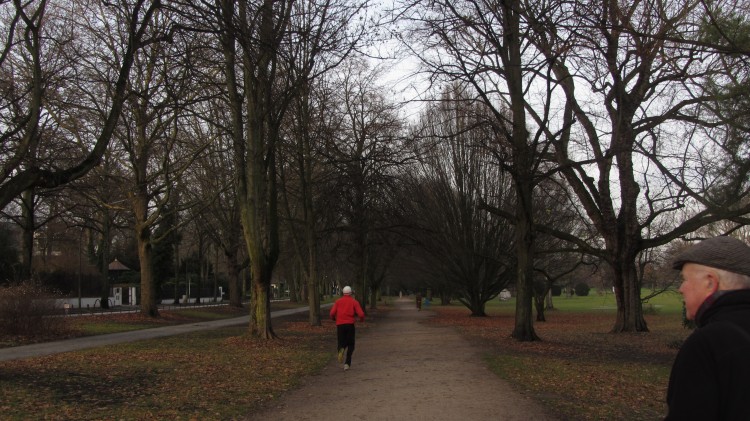Yearn to Wander
Greetings from Hamburg
We came because it was on the way to Berlin, which we never reached, but we also found another wonderful city. In fact, Hamburg was voted the tenth most liveable city in the world in 2010.
It's easy to see why from a tourist's perspective: two lakes in the middle of the city, excellent public transportation, lots of interesting history, good music, museums, and restaurants, clean streets, and friendly people. Everyone helps us with our German.
It's mid-December so the Christmas markets are in full swing. Gluehwein, wurst of all sorts, marones (roasted chestnuts), kucken of all varieties, and Christmas music, mostly in English, all add to the holiday cheer of crowds seemingly doing more eating and drinking than buying of Christmas gifts.
It's mid-December so we've encountered our first winter weather. Temperatures are just above freezing with rain, snow and hail and a little sunshine thrown in.
It's mid-December so the Fisch Markt, operated since 1703, is in full swing. As they say, anything that's not tied down is for sale. Add a lot of fresh fish to local favorites of cheese, wursts, breads, and flowers and the Fisch Markt is a real happening early Sunday morning.
Hamburg sits on the Elbe River and dozens of canals near the North Sea. The waterways support its significant industrial economy, which has grown over many centuries. Historically, Hamburg is an old city, so it's brought alive some of history we studied many years ago. Under Charlemagne in the ninth century, it became a bishopric; under The Holy Roman Empire in the twelfth century, it became the free imperial city that it remains today. In the thirteenth century, it joined the Hanseatic League, a powerful trading guild. In the sixteenth century, after it embraced Lutheranism, it became a refuge for those seeking freedom from religious persecution.
Its seat of government today is in the Rathaus, or City Hall, where municipal and state level governing takes place. The Neo-Renaissance sandstone building is a point of pride in this city-state officially called Die Freie und Hansestadt Hamburg (the Free and Hanseatic City of Hamburg).
Hamburg has experienced severe destruction several times in its history. More recently, a vast nineteenth century fire and heavy damage during The War (World War II), have required massive redevelopment efforts, so a mix of old and new architecture adds to the interest of the city.
It is Germany's largest port and Europe's third largest port, after Rotterdam and Antwerpen. Seventeenth century warehouses provide storage for companies from all over the world. Dry dock facilities offer ship repair space; P&O's Oriana cruise ship is in dock being refurbished. The river and canal banks host many operations including a Sasol refinery, a Shell storage facility, tens of container operations, and maintenance operations for anything related to sea-going trading and shipping.
It's been an exciting city to visit and we would like to return. Prosit! Cheers!
It's mid-December so the Christmas markets are in full swing. Gluehwein, wurst of all sorts, marones (roasted chestnuts), kucken of all varieties, and Christmas music, mostly in English, all add to the holiday cheer of crowds seemingly doing more eating and drinking than buying of Christmas gifts.
It's mid-December so we've encountered our first winter weather. Temperatures are just above freezing with rain, snow and hail and a little sunshine thrown in.
It's mid-December so the Fisch Markt, operated since 1703, is in full swing. As they say, anything that's not tied down is for sale. Add a lot of fresh fish to local favorites of cheese, wursts, breads, and flowers and the Fisch Markt is a real happening early Sunday morning.
Hamburg sits on the Elbe River and dozens of canals near the North Sea. The waterways support its significant industrial economy, which has grown over many centuries. Historically, Hamburg is an old city, so it's brought alive some of history we studied many years ago. Under Charlemagne in the ninth century, it became a bishopric; under The Holy Roman Empire in the twelfth century, it became the free imperial city that it remains today. In the thirteenth century, it joined the Hanseatic League, a powerful trading guild. In the sixteenth century, after it embraced Lutheranism, it became a refuge for those seeking freedom from religious persecution.
Its seat of government today is in the Rathaus, or City Hall, where municipal and state level governing takes place. The Neo-Renaissance sandstone building is a point of pride in this city-state officially called Die Freie und Hansestadt Hamburg (the Free and Hanseatic City of Hamburg).
Hamburg has experienced severe destruction several times in its history. More recently, a vast nineteenth century fire and heavy damage during The War (World War II), have required massive redevelopment efforts, so a mix of old and new architecture adds to the interest of the city.
It is Germany's largest port and Europe's third largest port, after Rotterdam and Antwerpen. Seventeenth century warehouses provide storage for companies from all over the world. Dry dock facilities offer ship repair space; P&O's Oriana cruise ship is in dock being refurbished. The river and canal banks host many operations including a Sasol refinery, a Shell storage facility, tens of container operations, and maintenance operations for anything related to sea-going trading and shipping.
It's been an exciting city to visit and we would like to return. Prosit! Cheers!
ms
2011-12-13
Copyright © 2010-2019 Marie N. Sprandel, All rights reserved.
Contact us at:
info@yearntowander.com





















